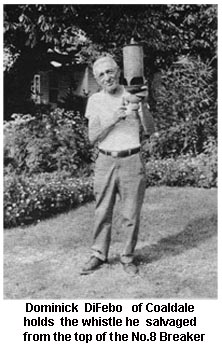If you’re wondering whatever happened to the No. 8 Breaker whistle, Dominick DiFebo is the man to ask.
Colliery whistles were once the Panther Valley’s alarm clocks. They blew at six o’clock in the morning to wake people up and they blew again at seven o’clock to signal the start of every work day. The next blast of the whistles came at 2:30 p.m.—quitting time. The only other time they blew was to signal an early quit in cases where mechanical or other trouble caused a shutdown of the breaker for the day.
 Dominick DiFebo of 334 East Water St., Coaldale, was more aware than most people of colliery whistles in the heydays of the Panther Valley’s deep mines. He lived directly across from the No. 8 Breaker and the clanking of the machinery and the lights behind the windows of the sheet iron monster at night were part of his life. But especially the whistle. Its shrill blasts of steam woke him up mornings for decades.
Dominick DiFebo of 334 East Water St., Coaldale, was more aware than most people of colliery whistles in the heydays of the Panther Valley’s deep mines. He lived directly across from the No. 8 Breaker and the clanking of the machinery and the lights behind the windows of the sheet iron monster at night were part of his life. But especially the whistle. Its shrill blasts of steam woke him up mornings for decades.
What caused DiFebo to develop a special feeling for the No. 8 Breaker whistle is the fact that he didn’t really have to get up at six o’clock in the morning. “I was on the second shift and started at 12:30,” he said.
DiFebo started his career in the mines “patching on the motor” in 1921 and he retired as a company miner when the No. 8 Colliery shut down.
So when the No. 8 Breaker was idled forever and slated for demolition, a plan took shape in Di Febo’s mind.
“After working 39 years and six months, I felt I had to have a souvenir,” he said. “I was entitled to a present.”
He decided it would be the thing whose single shrill shriek jolted him awake for most of the years of his life and which was now finally silent.
He took a walk to the breaker. The whistle was affixed to the side of a building near the breaker called “the dump.” It was where mine cars loaded with coal were dumped into the gondolas which carried the coal to the top of the breaker for the downward journey through the crushing, sorting, sizing and cleaning processes until it emerged at the bottom ready for loading into coal cars and trucks.
DiFebo studied the situation and went home without the whistle.
But the next morning he was back. This time he had a big monkey wrench and a hammer. He would need something to climb up to where the whistle was, so he got two 10-foot planks and nailed them together. He nailed strips of wood to the planks to make crude steps. He put this 20-foot improvised ladder against the building and made his way to a sloping sheet-iron roof, then he walked across the roof to reach the whistle.
When he reached it, he discovered that getting it loose wasn’t going to be easy.
“I had a helluva time,” he said. “It was rusted fast after all the years, from the steam. Finally I hammered around the couplings and got it loose. When I started to carry the damn thing down I had a helluva time getting a foothold on the planks. I didn’t like to throw the whistle down and maybe nick it or break it. About half way down one of the cross-pieces slipped out of the nails. That scared the hell out of me. Scared or not, I brought the old whistle down.”
He’s had it ever since.
“Anybody interested to know where the whistle ever went—I have it,” DiFebo said one sunny Saturday morning in October while seated outside his kitchen door near his garden where a profusion of gold and yellow flowers bloomed. His Ivy League cap was pulled down at a jaunty angle, keeping the sun out of his eyes.
“And I’m willing to replace it when Mr. Dodson will reopen No. 8,” he added. “I’m willing to put it back any place he wants it to help some people make a living.”
Considering that there’s nothing now but empty space where No. 8 used to be, there seems to be little likelihood that Dominick DiFebo will ever have to give up the whistle he went to so much trouble to get.



